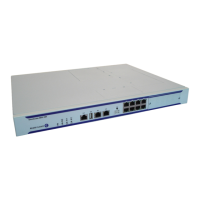Virtual Leased Line Services
7750 SR OS Services Guide Page 117
around 8 Mbps. Scheduling does not apply a limit to the transmission rate; the available port
bandwidth is shared out by the scheduler according to the weight, so if other flows are quiescent, a
given flow may burst up to port bandwidth.
Shaping and scheduling of egress ATM VLL traffic is performed entirely at the ATM layer and is
therefore not forwarding-class-aware. If the offered rate is greater than can be transmitted towards
the customer (either because the shaping rate limits transmission or because the SAP does not
receive sufficient servicing in the weighed round-robin used for scheduled SAPs), the per-VC
queue will back up and this will trigger the congestion control mechanisms in the MDA queues or
in the IOM service egress queues associated with the SAP. For AAL5 SDU VLLs, these discards
occur at the AAL5 SDU level. For N-to-1 VLLs, these discards occur at the level of the cell or a
block of cells when cell concatenation is enabled.
Table 1: Behavior and Relative Priorities
Flow type Transmission rate Priority
shaped CBR Limited to configured PIR Strict priority over all other traffic
shaped rtVBR Limited to configured SIR, but with bursts up to
PIR within MBS
Strict priority over all but shaped CBR
shaped nrtVBR Limited to configured SIR, but with bursts up to
PIR within MBS
Strict priority over all scheduled traffic
scheduled
nrtVBR
Weighted share (according to SIR) of port
bandwidth remaining after shaped traffic has
been exhausted
In the same WRR scheduler as UBR+
and UBR
scheduled UBR+ Weighted share (according to MIR) of port
bandwidth remaining after shaped traffic has
been exhausted
In the same WRR scheduler as nrtVBR
and UBR
scheduled UBR Weighted share (with weight of 1) of port
bandwidth remaining after shaped traffic has
been exhausted
In the same WRR scheduler as nrtVBR
and UBR+

